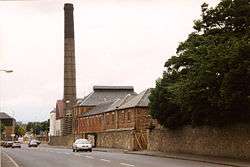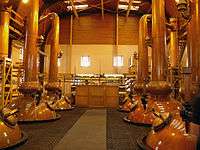Rosebank distillery
|
Rosebank Distillery 2006 | |
| Region: Lowland | |
|---|---|
| Location | Camelon Coordinates: 56°00′08.7″N 3°48′13.0″W / 56.002417°N 3.803611°W |
| Owner | Diageo Scotland |
| Founded | 1798 |
| Founder | Stark Brothers |
| Status | Decommissioned |
| Water source | Carron Valley Reservoir |
| Number of stills | three pot, two wash, one spirit |
| Capacity | 559,169.301 litres per year |
| Mothballed | 1993 to 2002 |
| Website | http://www.malts.com |
| Rosebank 1990 (2011) | |
| Type | Lowland |
| Age(s) | 21 years old |
| Cask type(s) | oak |
| ABV | 53.80% |
| Characteristics | fruit/floral |
| Rosebank 1990 - Mission (2011) | |
| Type | Lowland |
| Age(s) | 21 years old |
| Cask type(s) | oak |
| ABV | 54.60% |
| Characteristics | fruit/floral |
| Rosebank 1990 - Old Malt Cask (2009) | |
| Type | Lowland |
| Age(s) | 19 years old |
| ABV | 50% |
| Characteristics | fruit/floral |
| Rosebank 1991 - Connoisseurs Choice (2008) | |
| Type | Lowland |
| Age(s) | 17 years old |
| ABV | 43% |
| Characteristics | fruit/floral |
The Rosebank distillery was situated in Camelon on the banks of the Forth and Clyde canal between Edinburgh and Glasgow. Its name originated after the roses which grew along the side of the canal.[1]
History
Records exists, showing that a distillery existed in Falkirk as early as 1798, it was run by the Stark brothers in Laurieston.[2] In 1817, James Robertson opened a distillery nearby named Rosebank - records are unclear as to whether this was in the same location as the later distillery. It remained open only until 1819.[3] In 1827 John Stark (of the brothers) opened Camelon distillery on the west bank of the canal, he ran this until his death in 1836. After this time the Camelon distillery was run by Thomas Gunn and his father. In 1840 the Gunn's were approached by James Rankine to either buy or lease the Camelon distillery Maltings (on the east bank of the canal) where he set up a new distillery under the Rosebank name.[3] The new Rosebank quickly grew, requiring expansion in 1845 and rebuilding in 1864. Indeed in 1861 when Camelon Distillery went bankrupt, Rankine was able to purchase it as well and demolish it, leaving only the maltings for the use of Rosebank.[3] Rosebank Distillery Ltd was formed in 1894, and in 1914 it was among the companies that amalgamated to form the Scottish Malt Distillers. Later the group became part of DCL.[4]
In 1886, the distillery was visited by Alfred Barnard, who noted that it was set across two sites one on each side of the canal with a swing bridge linking the pair. The malt was produced in the former Camelon maltings on the west side of the canal, then would be transferred over to the distillery on the east side by means of the swing bridge. He also noted that their warehouse at the time had storage for 500,000 gallons (1,892,705.9 litres)[4]
Rosebank was once considered one of the premier lowland whiskies but United Distillers mothballed the distillery in 1993.[5] The reason given for the mothballing was that its effluent treatment would have required a £2m upgrade in order to comply with European standards of the time, this did not make it commercially viable. At the time of its closure, it still retained many historical features in the production of the whisky.[1]
By 1988, the bonded warehouse for the distillery (on the west bank of the canal) had been sold off and redeveloped, partially becoming a Beefeater Pub and Grill.[6]
In 2002, the distillery buildings and contents were sold to British Waterways by Diageo, and the maltings were demolished to make way for a housing development.[2][7] In 2008 plans were started to open a new distillery in Falkirk original Rosebank equipment.[8] However over Christmas and New Year 2008/2009, the original Rosebank Stills (along with other equipment) were stolen by metal thieves and were not recovered.[2] Plans for the new distillery have continued to develop gaining Scottish Government approval, the new building being near the Laurieston site of the original Rosebank distillery. Despite suggestion that the new whisky may be produced under the Rosebank name, Diageo - who own the Rosebank trademark and continue to release limited bottles of original Rosebank whisky - have denied this.[9]
Taste and Reviews
Rosebank is similar to other lowland single malts in having a taste associated with fruits, grasses, and particularly flowers,[10] Being casked in oak lends to oak flavourings within the malt as well - the distillery described the nose as "light and distinctive" and the flavour "well balanced".[1] The late writer Michael Jackson, described the whisky as “The finest example of a Lowland malt…” and considered the closure of the distillery “…a grievous loss.” [11] In his "Complete book of Whisky", Jim Murray notes that a previous writer[fn 1] could not be taken seriously after making the claim that "none of them [Lowland malts] approaches the sunny majesty of the Highland malts..." - Murray maintains that Rosebank is the "superior Lowlander" and should be ranked in the top five of all Scottish malts.[1]
Footnotes
- ↑ Brian Murphy in his World Book of Whisky(1978)
Bibliography
- Townsend, Brian (2000). Scotch Missed: The Lost Distilleries of Scotland (3 ed.). Neil Wilson Publishing Ltd. ISBN 9781897784976.
- Murray, Jim (1997). Jim Murray's complete book of whisky: the definitive guide to the whiskys of the world (2 ed.). Carlton. ISBN 1858684226.
- Gill, Michael (2006). Whisky Today. Trafford Publishing. ISBN 1412083281.
References
- 1 2 3 4 Murray 1997, p. 95.
- 1 2 3 "Sneak thieves stage raid on old distillery". The Falkirk Herald. 22 January 2009.
- 1 2 3 Townsend 2000, p. 118.
- 1 2 Townsend 2000, p. 119.
- ↑ Townsend 2000, pp. 119-120.
- ↑ "Beefeater goes for it". Caterer & Hotelkeeper. IPC Consumer Industries Press. 179. 1988.
- ↑ Townsend 2000, p. 120.
- ↑ "80 Say Cheers To Whisky Jobs". Sunday Mail. 5 October 2008.
- ↑ "Approval for £5m Falkirk whisky distillery". BBC Online. 27 May 2010. Retrieved 29 March 2012.
- ↑ Gill 2009, p. 68.
- ↑ Smith, Gavin D. (July 2007). "A grievous loss (Rosebank)". Whisky Magazine (65): 31.
| Wikimedia Commons has media related to Rosebank Distillery. |

